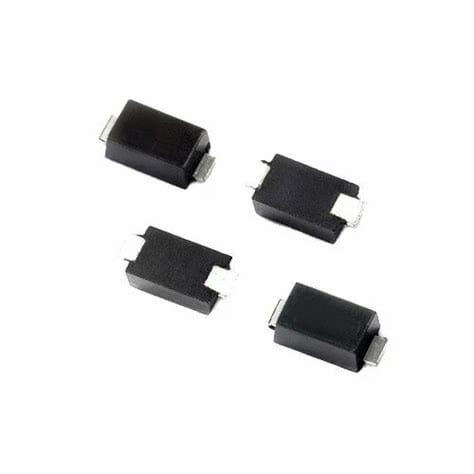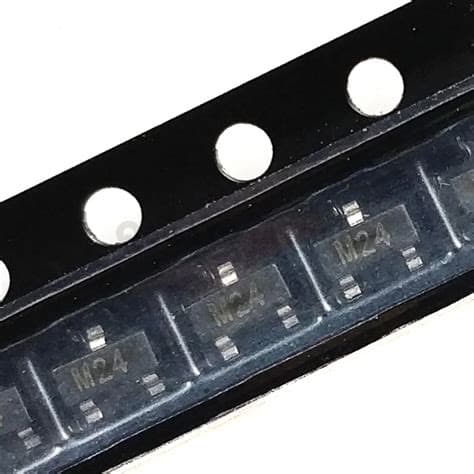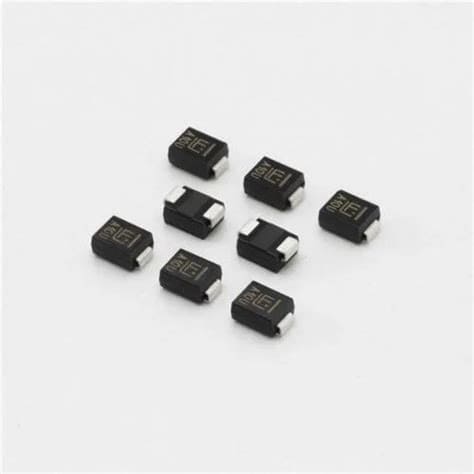What is a TVS Diode?
A TVS diode is a type of Zener diode optimized for use in transient voltage suppression applications. Unlike regular Zener diodes, which are designed for voltage regulation, TVS diodes are engineered to handle high-energy voltage spikes and provide fast response times.
When exposed to a voltage transient that exceeds its breakdown voltage, a TVS diode will rapidly switch from a high-resistance state to a low-resistance state, effectively clamping the transient voltage to a safe level. This clamping action protects the sensitive electronic components connected to the TVS diode from damage.
How Does a TVS Diode Circuit Work?
In a typical TVS diode circuit, the diode is connected in parallel with the device or component it is intended to protect. Under normal operating conditions, the TVS diode remains in a high-resistance state and does not affect the circuit’s performance.
However, when a voltage transient occurs that exceeds the TVS diode’s breakdown voltage, the diode will quickly switch to a low-resistance state, shunting the excess current away from the protected device and clamping the voltage to a safe level. Once the transient has passed, the TVS diode automatically resets to its high-resistance state, ready to protect against future transients.
Key Characteristics of TVS Diodes
To effectively select and use TVS diodes in circuit protection applications, it’s essential to understand their key characteristics:
-
Breakdown Voltage (VBR): The voltage at which the TVS diode begins to conduct and clamp the transient voltage. This value is chosen based on the maximum operating voltage of the protected device.
-
Peak Pulse Power (PPP): The maximum power the TVS diode can dissipate during a transient event. This value depends on the diode’s size and construction.
-
Peak Pulse Current (IPP): The maximum current the TVS diode can handle during a transient event.
-
Clamping Voltage (VC): The maximum voltage that will appear across the TVS diode during a transient event when the diode is conducting.
-
Response Time: The time it takes for the TVS diode to switch from its high-resistance state to its low-resistance state when a transient occurs. Faster response times provide better protection for sensitive electronics.
Here’s a table summarizing these key characteristics for a few common TVS diodes:
| TVS Diode | VBR (V) | PPP (W) | IPP (A) | VC (V) | Response Time (ns) |
|---|---|---|---|---|---|
| SMAJ5.0A | 5.0 | 400 | 43.5 | 9.2 | <1 |
| SMAJ12A | 12.0 | 400 | 24.4 | 19.9 | <1 |
| SMAJ24A | 24.0 | 400 | 12.2 | 38.9 | <1 |
Unidirectional vs. Bidirectional TVS Diodes
TVS diodes come in two main types: unidirectional and bidirectional. Unidirectional TVS diodes are designed to protect against transients of a single polarity, either positive or negative. They are typically used in DC circuits where the polarity of the voltage is known and consistent.
On the other hand, bidirectional TVS diodes can protect against both positive and negative transients. They are commonly used in AC circuits or in applications where the polarity of the transient voltage is unknown or can change.

Applications of TVS Diode Circuits
TVS diode circuits are used in a wide range of applications to protect sensitive electronics from voltage transients. Some common applications include:
-
Power Supply Protection: TVS diodes are often used to protect the inputs and outputs of power supplies from voltage spikes and surges.
-
Data Line Protection: In communication systems, TVS diodes safeguard data lines (e.g., USB, Ethernet, RS-232) from transients that could cause data corruption or device damage.
-
Automotive Electronics: TVS diodes protect sensitive automotive electronics, such as engine control units and infotainment systems, from voltage spikes caused by load dump events or other transients.
-
Industrial Equipment: In industrial settings, TVS diodes shield control systems, sensors, and actuators from voltage transients caused by switching inductive loads or lightning strikes.
-
Medical Devices: TVS diodes are used in medical equipment to protect sensitive electronics from voltage transients and ensure patient safety.

Selecting the Right TVS Diode
When choosing a TVS diode for a specific application, consider the following factors:
-
Maximum Operating Voltage: The TVS diode’s breakdown voltage (VBR) should be higher than the circuit’s maximum operating voltage to avoid inadvertent clamping during normal operation.
-
Transient Energy: The TVS diode must be capable of dissipating the expected transient energy without being damaged. This is determined by the diode’s peak pulse power (PPP) and peak pulse current (IPP) ratings.
-
Clamping Voltage: The clamping voltage (VC) should be low enough to protect the sensitive components in the circuit from damage.
-
Response Time: For applications with fast transients, such as ESD protection, choose a TVS diode with a fast response time to ensure effective clamping.
-
Package Type: TVS diodes are available in various package types, such as SMD, through-hole, and surface mount. Choose a package that is compatible with your circuit design and manufacturing process.

Designing with TVS Diodes
When incorporating TVS diodes into your circuit design, keep the following best practices in mind:
-
Placement: Position the TVS diode as close as possible to the device or component it is protecting to minimize the effects of Parasitic Inductance and ensure optimal clamping performance.
-
Grounding: Ensure that the TVS diode is properly grounded to provide a low-impedance path for the transient current to flow.
-
Thermal Management: In applications with high transient energy levels or frequent transient events, consider the TVS diode’s thermal management requirements. Use appropriate heat sinking or thermal relief techniques to prevent overheating and ensure long-term reliability.
-
Coordination with Other Protection Devices: When using TVS diodes in conjunction with other protection devices, such as fuses or Circuit Breakers, ensure proper coordination between the devices to avoid interference and guarantee effective overall protection.
Frequently Asked Questions (FAQ)
-
Q: Can a TVS diode protect against lightning strikes?
A: While TVS diodes can provide some protection against lightning-induced transients, they are not designed to handle the extremely high energy levels associated with direct lightning strikes. For comprehensive Lightning Protection, additional measures, such as lightning arresters and proper grounding, should be employed in conjunction with TVS diodes. -
Q: How do TVS diodes differ from metal oxide varistors (MOVs)?
A: Both TVS diodes and MOVs are used for transient voltage suppression, but they have some key differences. TVS diodes have faster response times, lower clamping voltages, and better energy dissipation capabilities compared to MOVs. However, MOVs can handle higher peak pulse currents and are often used in applications with high-energy transients, such as power line protection. -
Q: Can I use multiple TVS diodes in parallel for increased protection?
A: Yes, using multiple TVS diodes in parallel can increase the overall peak pulse current and energy handling capability of the protection circuit. However, it’s essential to ensure that the diodes are closely matched in terms of their electrical characteristics to prevent uneven current sharing and potential device failure. -
Q: How do I test a TVS diode to ensure it is functioning correctly?
A: To test a TVS diode, you can use a curve tracer or a combination of a voltage source and a current meter. Gradually increase the voltage across the diode and monitor the current. The diode should remain in a high-resistance state until the voltage reaches its breakdown voltage, at which point the current should increase rapidly. Ensure that the clamping voltage and leakage current are within the manufacturer’s specifications. -
Q: Can TVS diodes protect against electrostatic discharge (ESD)?
A: Yes, TVS diodes are commonly used for ESD protection in various applications, such as protecting data lines and sensitive electronic components. When selecting a TVS diode for ESD protection, choose a device with a fast response time and a low clamping voltage to ensure effective protection against the fast-rising and high-voltage nature of ESD events.
Conclusion
TVS diode circuits play a crucial role in protecting sensitive electronics from voltage transients and ensuring the reliable operation of electronic systems. By understanding the key characteristics and applications of TVS diodes, engineers and designers can effectively select and implement these devices in their designs.
When designing with TVS diodes, consider factors such as the maximum operating voltage, transient energy levels, clamping voltage, response time, and package type. Proper device placement, grounding, thermal management, and coordination with other protection devices are also essential for optimal performance.
As electronic systems continue to advance and become more complex, the importance of robust transient voltage protection will only grow. By leveraging the capabilities of TVS diode circuits, designers can create more resilient and reliable electronic products that can withstand the challenges of today’s demanding environments.

No responses yet